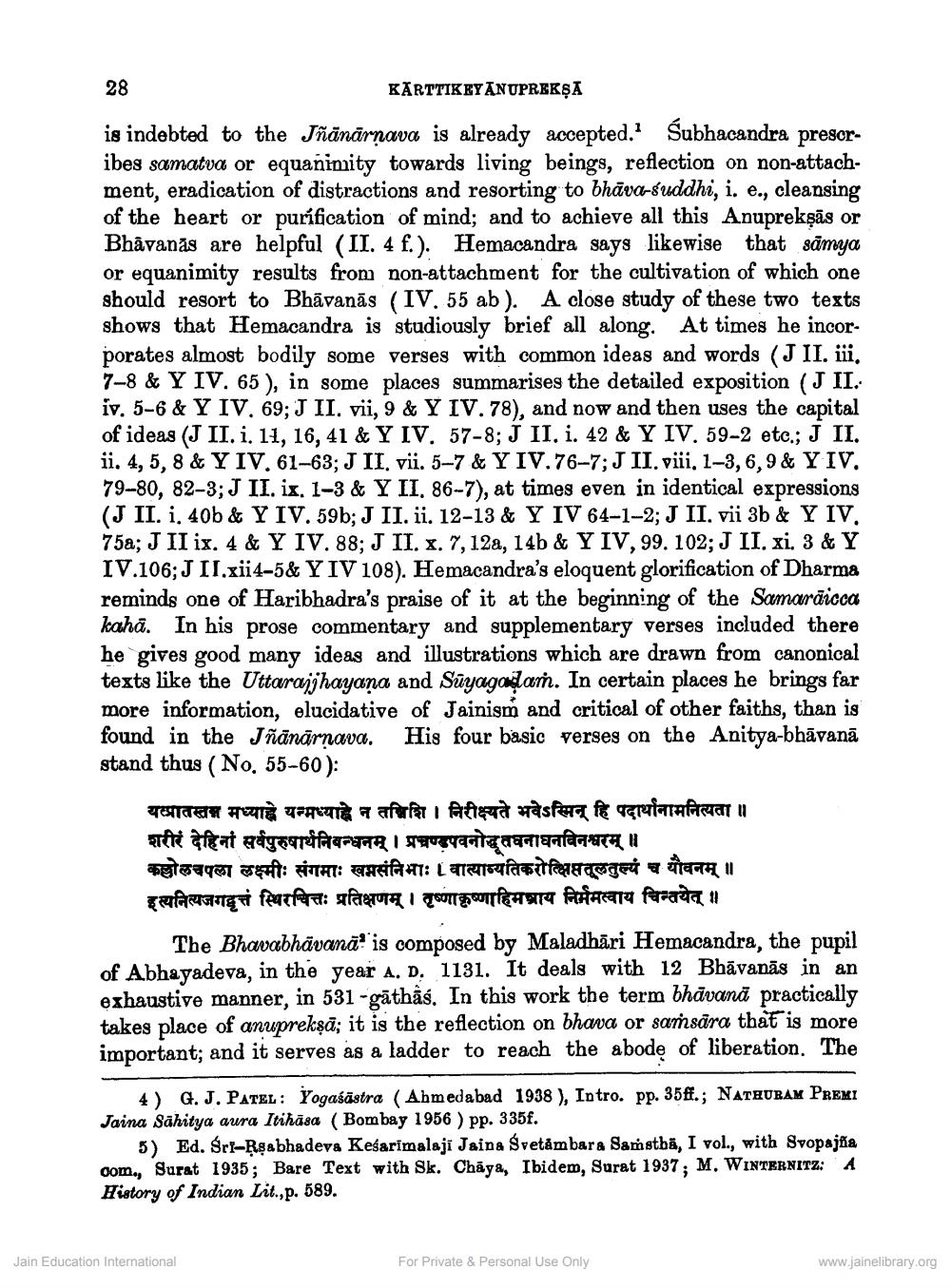________________
28
KĀRTTIKEYANUPREKŞA
is indebted to the Jñānārņava is already accepted. Subhacandra prescribes samatva or equanimity towards living beings, reflection on non-attachment, eradication of distractions and resorting to bhāva-suddhi, i. e., cleansing of the heart or purification of mind; and to achieve all this Anuprekşās or Bhāvanās are helpful (II. 4 f.). Hemacandra says likewise that sămya or equanimity results from non-attachment for the cultivation of which one should resort to Bhāvanās (IV. 55 ab). A close study of these two texts shows that Hemacandra is studiously brief all along. At times he incorporates almost bodily some verses with common ideas and words (JII. iii. 7-8 & Y IV. 65 ), in some places summarises the detailed exposition (J II. iv. 5-6 & Y IV. 69; J II. vii, 9 & Y IV. 78), and now and then uses the capital of ideas (J II. i. 11, 16, 41 & Y IV. 57-8; J II. i. 42 & Y IV. 59-2 etc.; J II. ii. 4, 5, 8 & Y IV. 61-63; J II. vii. 5–7 & Y IV.76–7;J II. viii, 1–3, 6,9 & YIV. 79-80, 82-3;J II. ix. 1-3 & Y II. 86-7), at times even in identical expressions (J II. i, 40b & Y IV. 59b; J II. ii. 12-13 & Y IV 64-1-2; J II. vii 3b & Y IV. 75a; J II ix. 4 & Y IV. 88; J II. x. 7,12a, 14b & Y IV, 99. 102; J II. xi. 3 & Y IV.106;J II.xii4-5& Y IV 108). Hemacandra's eloquent glorification of Dharma reminds one of Haribhadra's praise of it at the beginning of the Samarāicca kahā. In his prose commentary and supplementary verses included there he gives good many ideas and illustrations which are drawn from canonical texts like the Uttarajjhayana and Sūyagala. In certain places he brings far more information, elucidative of Jainism and critical of other faiths, than is found in the Jñānārnava. His four basic verses on the Anitya-bhāvanā stand thus (No. 55-60 ):
यप्रातस्तन मध्याह्वे यन्मध्याहेन तनिशि। निरीक्ष्यते भवेऽस्मिन् हि पदार्थानामनित्यता॥ शरीरं देहिनां सर्वपुरुषार्थनिबन्धनम् । प्रचण्डपवनोद्धृतधनाधनबिनश्वरम् ॥ कल्लोलचपला लक्ष्मीः संगमाः खमसंनिभाः । वात्याव्यतिकरोक्षिप्ततूलतुल्यं च यौवनम् ॥ इस्यनित्यजगद्वृत्तं स्थिरचित्तः प्रतिक्षणम् । तृष्णाकृष्णाहिमप्राय निर्ममत्वाय चिन्तयेत् ॥
The Bhavabhāvanā! is composed by Maladhāri Hemacandra, the pupil of Abhayadeva, in the year A. D. 1131. It deals with 12 Bhāvanās in an exhaustive manner, in 531 - gāthâs. In this work the term bhāvanā practically takes place of anuprekşā; it is the reflection on bhava or saṁsāra that is more important; and it serves as a ladder to reach the abode of liberation. The
4) G. J. PATEL: Yogaśāstra (Ahmedabad 1938 ), Intro. pp. 35ff.; NATHURAM PREMI Jaina Sahitya aura Itihāsa (Bombay 1956 ) pp. 335f.
5) Ed. Sri-Rşabhadeva Kesarimalaji Jaina Svetămbara Samstbå, I vol., with Svopajia oom., Surat 1935; Bare Text with Sk. Chāya, Ibidem, Surat 1937; M. WINTERNITZ: A History of Indian Lit., p. 589.
Jain Education International
For Private & Personal Use Only
www.jainelibrary.org




